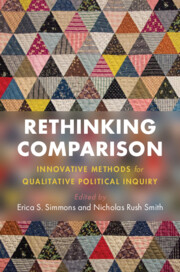Book contents
- Frontmatter
- Dedication
- Contents
- List of Figures
- List of Tables
- List of Contributors
- Acknowledgments
- 1 Rethinking Comparison: An Introduction
- Part I Rethinking the Building Blocks of Comparison
- Part II Developing New Approaches to Comparison through Research
- 7 Comparing Complex Cases Using Archival Research
- 8 Composing Comparisons: Studying Configurations of Relations in Social Network Research
- 9 Against Methodological Nationalism: Seeing Comparisons as Encompassing through the Arab Uprisings
- 10 Comparative Analysis for Theory Development
- 11 Problems and Possibilities of Comparison across Regime Types: Examples Involving China
- 12 Comparisons with an Ethnographic Sensibility: Studies of Protest and Vigilantism
- Theory and Imagination in Comparative Politics: An Interview with Lisa Wedeen
- Index
10 - Comparative Analysis for Theory Development
from Part II - Developing New Approaches to Comparison through Research
Published online by Cambridge University Press: 24 September 2021
- Frontmatter
- Dedication
- Contents
- List of Figures
- List of Tables
- List of Contributors
- Acknowledgments
- 1 Rethinking Comparison: An Introduction
- Part I Rethinking the Building Blocks of Comparison
- Part II Developing New Approaches to Comparison through Research
- 7 Comparing Complex Cases Using Archival Research
- 8 Composing Comparisons: Studying Configurations of Relations in Social Network Research
- 9 Against Methodological Nationalism: Seeing Comparisons as Encompassing through the Arab Uprisings
- 10 Comparative Analysis for Theory Development
- 11 Problems and Possibilities of Comparison across Regime Types: Examples Involving China
- 12 Comparisons with an Ethnographic Sensibility: Studies of Protest and Vigilantism
- Theory and Imagination in Comparative Politics: An Interview with Lisa Wedeen
- Index
Summary
What does it mean to advance women’s status and well-being? And how should we think about the role of the state in bringing about that advancement? Our work analyzes the approach and role of the state in promoting women’s empowerment, drawing on large-N country-level data and in-depth case studies of state action in the United States, Norway, and Japan. Our three country cases vary greatly in terms of the state’s approach to women’s rights; we picked them because we believe them to be extreme examples of how state action is driven by different visions of what women’s empowerment is about. Conducting fieldwork in these different contexts allows us to study some of the variation in people’s views of both state action and empowerment. It sharpens our awareness of important assumptions that underlie studies of empowerment. It also helps us determine the right questions to ask. To the extent that we study causal relationships, we do so based on large-N data within cases, not across them. And rather than assume that the same causal patterns apply across cases, we draw on our fieldwork to better understand why the same policies produce vastly different effects in different contexts. This chapter is a reflection on some of the goals of comparative studies that are unrelated to drawing causal inferences, and how to think about research design and case selection to achieve these goals.
Keywords
Information
- Type
- Chapter
- Information
- Rethinking ComparisonInnovative Methods for Qualitative Political Inquiry, pp. 190 - 207Publisher: Cambridge University PressPrint publication year: 2021
Accessibility standard: Unknown
Why this information is here
This section outlines the accessibility features of this content - including support for screen readers, full keyboard navigation and high-contrast display options. This may not be relevant for you.Accessibility Information
- 6
- Cited by
